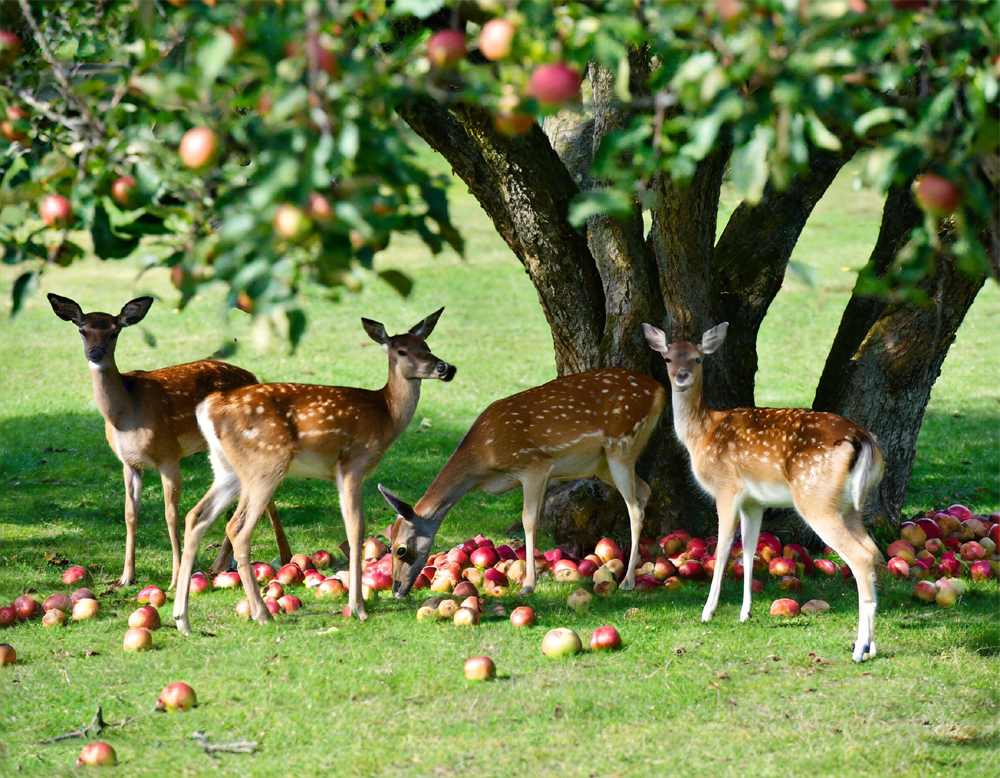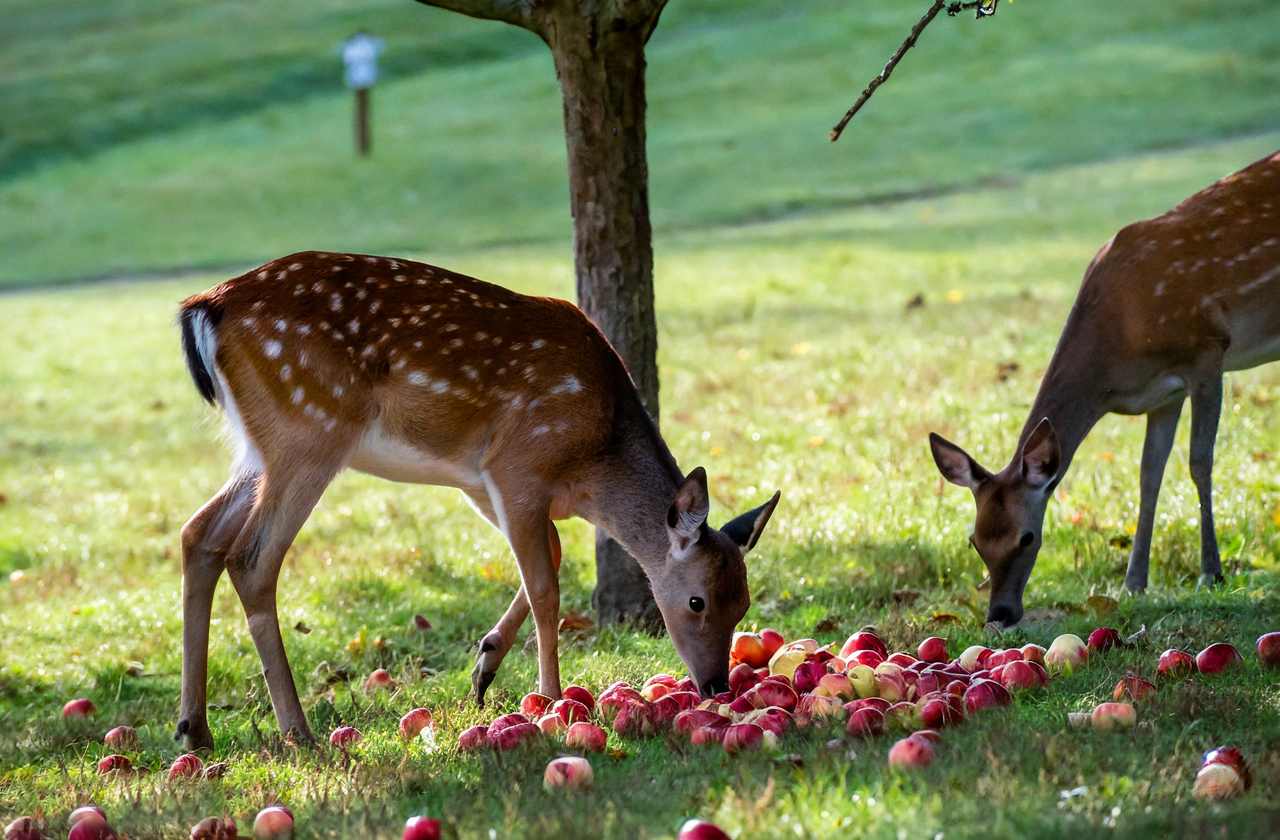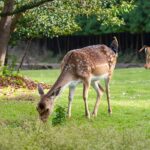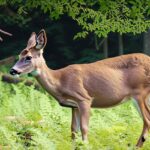Yes, deer eat apples and enjoy them, both fresh and even the slightly aged ones. While apples may be a delicious addition to their diet, it’s important to provide them carefully. Although deer love the flavor, consuming too many overripe or rotten apples may get them intoxicated. To minimize the risk of exposure to preservatives or chemical residues from unwashed fruits, it is recommended to provide cleaned apples. While apples are a delicious treat for deer, it’s crucial to keep in mind that apples are only one aspect of their broad and varied diet.
While apples aren’t a staple in a deer’s diet, they’re not entirely off the menu either. Deer, known for their adaptability, embrace an opportunistic approach to food, adjusting their meals to the resources available. This means that when faced with an abundance of apples, especially during times of food scarcity, these graceful herbivores might indeed partake in a delightful apple feast.
Unraveling the Why, When, and How of Deer Apple Delectation
Several factors influence a deer’s decision to incorporate apples into its culinary repertoire:

- Seasonal Symphony: Apples ripen in the autumn, coinciding with a period when their usual forage, like leaves and grasses, becomes less plentiful. This makes apples an attractive alternative, offering a readily available source of energy and essential nutrients.
- Accessibility Matters: Deer are more likely to indulge in apples when they’re easily accessible, like fallen fruit from orchards or backyards. Apples hanging high in trees are less tempting targets.
- Nutritional Needs and Delights: Apples provide deer with a decent dose of carbohydrates and sugars for energy, along with vitamins and minerals like vitamin C and potassium. However, they lack the essential protein and fiber found in their natural diet of leaves, twigs, and grasses.
A Look at Deer’s Diverse Dietary Palette
While apples might steal the spotlight, a deer’s diet is a much richer and more diverse tapestry. Their primary food sources include:
- Browse: Leaves, twigs, and stems of woody plants like shrubs and trees.
- Forbs: Herbaceous plants like clover, dandelions, and wildflowers.
- Grasses: Various types of grasses, particularly in spring and summer.
- Fruits and Nuts: Deer may occasionally enjoy other fruits and nuts like berries, acorns, and hickory nuts.
Balancing Nutritional Needs and Opportunistic Feasts
While apples can offer a temporary energy boost, they’re not a complete meal for deer. Their high sugar content can lead to digestive problems if consumed in large quantities, especially for young fawns. Additionally, an overreliance on apples can displace the consumption of essential nutrients found in their natural diet, potentially impacting their overall health and well-being.
Responsible Apple Management Strategies
If you find your apple trees becoming a popular deer buffet, consider these responsible management practices:

- Pick up fallen apples regularly: This reduces their availability and discourages deer from lingering in your orchard.
- Tree fencing: Install fencing around young trees to deter deer from reaching the fruit.
- Natural repellents: Apply deer-repellent sprays or use odor-based deterrents like garlic or hot pepper flakes around trees.
- Habitat diversification: Plant a variety of native trees and shrubs to offer deer a more diverse natural food source, reducing their dependence on your apple bounty.
Conclusion
So, do deer eat apples? The answer is a resounding yes, but with caveats. They’re not apple-obsessed herbivores, instead fitting the role of curious opportunists. So, while your fallen apples may indeed tempt a passing deer, they won’t necessarily become their main course.
By understanding the relationship between deer and apples, we can appreciate their opportunistic nature while practicing responsible management strategies that benefit both humans and wildlife. Remember, a healthy and diverse diet is key for both deer and us, and finding a balance is crucial for harmonious co-existence. So, the next time you hear the crunch of leaves underfoot or catch a glimpse of a deer in your orchard, remember the story behind their apple-snacking adventure. It’s a tale of adaptation, resourcefulness, and the delicate dance between humans and nature.
FAQ
1. Do deer eat apples all year round?

No, deer primarily eat leaves, twigs, and grasses, which provide essential fiber and protein. Apples are a seasonal treat, enjoyed mainly in the fall when their natural forage becomes scarce. During this period, fallen apples offer a readily available source of sugars and vitamins. However, deer wouldn’t rely on them as a year-round staple.
2. Are apples healthy for deer?
While apples can provide a temporary energy boost for deer, they lack the crucial fiber and protein found in their usual diet. Overindulgence in apples can lead to digestive issues, especially for young fawns. Additionally, relying heavily on apples can displace the consumption of essential nutrients from their natural diet, potentially impacting their overall health and well-being.
3. Do deer prefer specific types of apples?
Deer are more likely to eat fallen apples that are easily accessible and ripe. They aren’t picky about varieties, but the sweeter, softer fruits are generally more appealing. High-hanging apples or harder, less sweet varieties might be left untouched unless hunger drives them to explore further.
4. Can deer eat apple cores or seeds?
Deer can technically eat apple cores and seeds, but they usually avoid them. Small levels of cyanide, which may be dangerous if consumed in excessive numbers, are present in the seeds. Additionally, the cores are tough and difficult to digest, offering little nutritional value.
5. What can I do to discourage deer from eating my apples?
If deer are feasting on your apple trees, consider these options:
- Pick up fallen apples regularly. This reduces their readily available food source and encourages deer to seek food elsewhere.
- Install tree fencing around young trees. This creates a physical barrier, preventing deer from reaching the fruit.
- Use deer-repellent sprays or odor-based deterrents. Strong-smelling options like garlic or hot pepper flakes can create an unappealing environment for deer.
- Plant a variety of native trees and shrubs. This provides deer with a more diverse natural food source, potentially reducing their reliance on your apple bounty.
- California Deer Hunting Guide: Seasons, Rules, Permits, and More - 26 June 2024
- Arkansas Deer Season 2024 [Schedules, Licenses, Bag Limits & More!] - 26 June 2024
- 2024 Arizona Deer Season New Dates & Rules! - 25 June 2024




